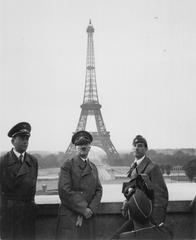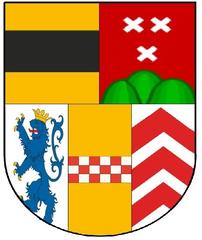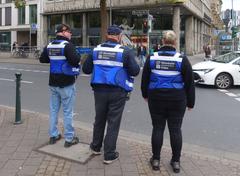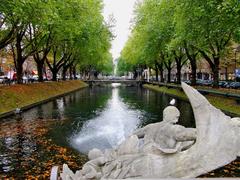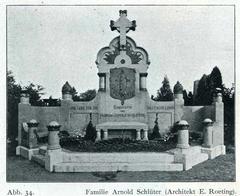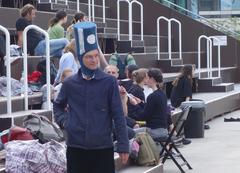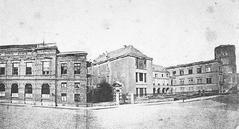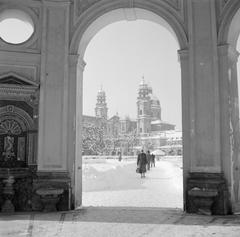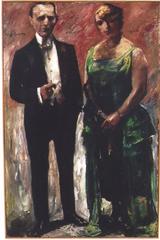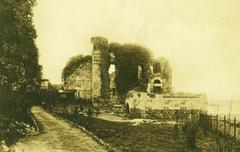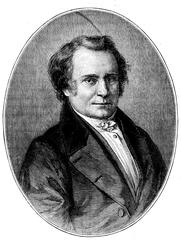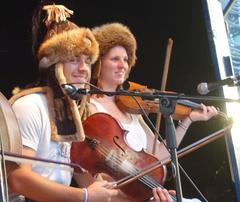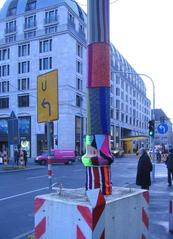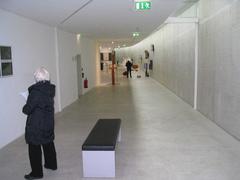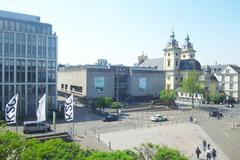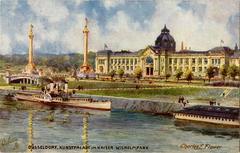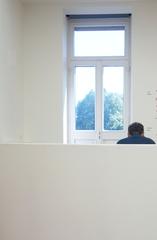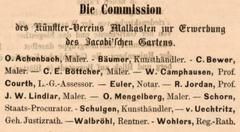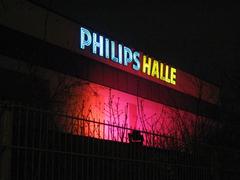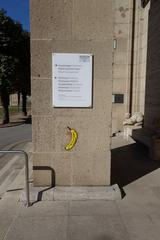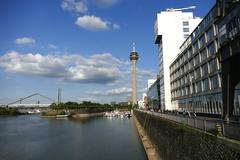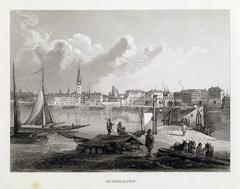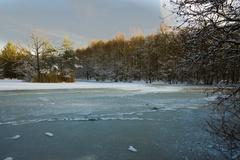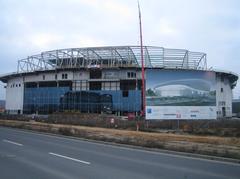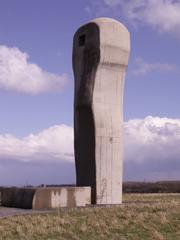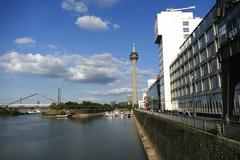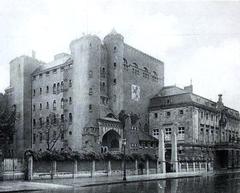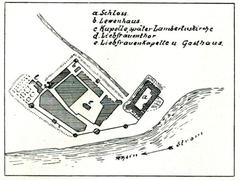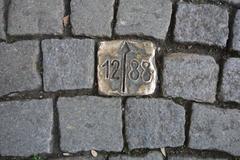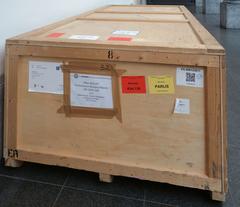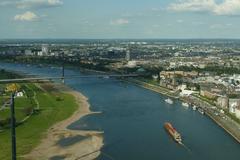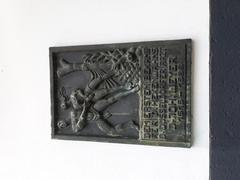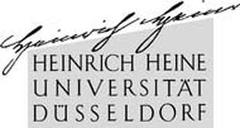Mannesmann-Haus Düsseldorf: Visiting Hours, Tickets & Complete Historical Guide
Date: 04/07/2025
Introduction
Mannesmann-Haus, prominently located along Düsseldorf’s scenic Rhine Promenade, is a landmark of early 20th-century industrial progress and architectural innovation. Originally the administrative heart of Mannesmannröhren-Werke AG, the building—completed in 1912—symbolizes the pioneering spirit of the Mannesmann brothers, who revolutionized steel pipe manufacturing with their invention of the seamless steel tube. Designed by Peter Behrens, one of Germany’s most influential architects, the Mannesmann-Haus complex is a blend of neoclassical and early modernist architecture, representing Düsseldorf’s transformation into a major economic and cultural center (Wikipedia: Mannesmann, Wikipedia: Peter Behrens).
Adjacent to the original Behrensbau is the Mannesmann-Hochhaus, a post-war modernist skyscraper built in the 1950s, together forming an ensemble that narrates Düsseldorf’s industrial resilience and architectural evolution. Over the decades, Mannesmann-Haus has played significant roles—from industrial headquarters to government seat, and most recently, as a future museum dedicated to North Rhine-Westphalia’s history.
This comprehensive guide provides detailed information on the Mannesmann-Haus’s history, architectural features, visiting hours, ticketing, accessibility, travel tips, and nearby attractions, ensuring a well-informed and rewarding visit.
Table of Contents
- Introduction
- Historical Development and Significance
- Architectural Highlights
- Role in Düsseldorf’s History
- The Mannesmann Affair
- Preservation, Adaptive Reuse & Future Museum
- Visiting Mannesmann-Haus
- Nearby Attractions & Travel Tips
- FAQs
- Summary & How to Stay Updated
- References
Historical Development and Significance
The Mannesmann-Haus traces its roots to 1886, when the Mannesmann brothers founded their steel manufacturing company. Their invention of the seamless steel tube transformed global industry, and Düsseldorf was chosen as headquarters for its strategic economic position. The administrative building, completed in 1912 and designed by Peter Behrens, became a symbol of industrial ambition and progress (Wikipedia: Mannesmann).
In the post-war era, the addition of the Mannesmann-Hochhaus marked a new chapter, reflecting both technological advancement and the city’s rapid redevelopment. From serving as the corporate headquarters to becoming the seat of North Rhine-Westphalia’s first postwar government and, later, a temporary home for refugees, the building’s adaptive reuse underscores its enduring civic importance (smow.com).
Architectural Highlights
Behrensbau (1912): Early Modernism Meets Industrial Prestige
Peter Behrens’ design for the original Mannesmann-Haus embodies the shift from historicism to early modernism. The building features a robust stone and brick façade with balanced proportions, restrained ornamentation, and large windows that flood the interiors with natural light. Notably, Behrens’ office included future luminaries such as Walter Gropius, Le Corbusier, and Ludwig Mies van der Rohe, who each contributed to the building’s design and engineering (de.wikipedia.org).
A key artistic element is the Hephaistos relief by sculptor Eberhard Encke, symbolizing craftsmanship and industry above the main entrance (globalculturalheritage.com).
Mannesmann-Hochhaus (1958): Postwar Modernism and Innovation
The Mannesmann-Hochhaus, completed in 1958, stands as one of Germany’s first modern skyscrapers. Its steel skeleton frame, curtain wall façade, and use of Mannesmann’s own steel tubes highlight the company’s industrial prowess. The tower’s slim profile and abundant glazing form a striking contrast with the Behrensbau’s monumental solidity (baukunst-nrw.de).
Role in Düsseldorf’s History
Beyond architecture, Mannesmann-Haus has been central to Düsseldorf’s industrial and political life. It was the site of strategic operations during both World Wars, witnessed postwar reconstruction, and served as the seat of North Rhine-Westphalia’s first government from 1946 to 1953 (smow.com). Its role in the landmark Vodafone takeover—the “Mannesmann Affair”—underscored its continued relevance in corporate and European economic history (BBC News: Vodafone seals Mannesmann deal).
The Mannesmann Affair
In 2000, Mannesmann AG was the target of a historic corporate takeover by Vodafone. This event, which played out within the walls of Mannesmann-Haus, was a milestone in European business history and signified the building’s role in pivotal economic developments (BBC News: Vodafone seals Mannesmann deal).
Preservation, Adaptive Reuse & Future Museum
Both the Behrensbau and Hochhaus are protected monuments, recognized for their architectural and historical significance (Denkmalliste Düsseldorf). Since 2020, Mannesmann-Haus has been undergoing extensive renovations to become the Haus der Geschichte Nordrhein-Westfalen, a museum dedicated to the state’s history. This transformation ensures the building’s preservation while expanding its role as a cultural and educational venue (globalculturalheritage.com).
Visiting Mannesmann-Haus
Hours, Tickets & Accessibility
- Current Status: As of 2025, Mannesmann-Haus is closed for renovations, with reopening as the Haus der Geschichte Nordrhein-Westfalen museum projected for late 2025.
- Visiting Hours (upon reopening): Expected to be Tuesday–Sunday, 10:00 AM–6:00 PM, with extended hours on select days.
- Tickets: Details will be announced closer to the reopening. Standard admission rates, with concessions for students, seniors, and groups, are anticipated. Advance online booking will be available.
- Accessibility: The new museum will be fully accessible, with elevators, ramps, and facilities for visitors with disabilities. Assistance for visually and hearing-impaired guests will also be provided.
- Guided Tours: Regular guided tours focusing on architecture and NRW history will be available, alongside special exhibitions and educational events.
- Exterior Viewing: The building’s exterior and its ensemble can be admired any time from the Rhine Promenade.
How to Get There
- Address: Mannesmannufer 2, 40213 Düsseldorf.
- By Tram: Lines 704, 709, and U75 (Graf-Adolf-Platz or Düsseldorf Altstadt stops).
- By Bus: Several bus lines serve the area; check Rheinbahn schedules.
- By Foot/Bike: The Rhine Promenade is ideal for walking or cycling; bike rental stations are nearby.
- Parking: Limited street parking; public transport is recommended.
Nearby Attractions & Travel Tips
- Altstadt (Old Town): Renowned for its historic pubs, churches, and vibrant nightlife.
- Kunsthalle Düsseldorf: Contemporary art museum within walking distance.
- Königsallee: Düsseldorf’s luxury shopping boulevard.
- Rheinturm (Rhine Tower): Offers panoramic city views and a revolving restaurant.
- MedienHafen: Hub of contemporary architecture, including buildings by Frank Gehry.
Travel Tips:
- Late afternoon offers ideal lighting for photography.
- Spring through early autumn is best for enjoying the promenade and city events.
- Respect the building’s active status and restricted areas during renovations.
Frequently Asked Questions (FAQ)
Q: When will Mannesmann-Haus reopen to visitors?
A: The reopening as the Haus der Geschichte Nordrhein-Westfalen museum is anticipated for late 2025. Check official tourism and museum websites for updates.
Q: How can I buy tickets for Mannesmann-Haus?
A: Ticketing details and online booking options will be available closer to the reopening.
Q: Are guided tours available?
A: Yes, guided tours focusing on the building’s architecture and NRW history will be offered after reopening.
Q: Is the building accessible for people with disabilities?
A: Yes, the renovated museum will have full accessibility features.
Q: Is photography allowed inside Mannesmann-Haus?
A: Photography policies will be posted at reopening; non-flash photography for personal use is typically permitted in museums.
Summary and How to Stay Updated
Mannesmann-Haus is a hallmark of Düsseldorf’s industrial heritage and architectural achievement, from Peter Behrens’ early modernist vision to its ongoing transformation into a museum of regional history. Although interior access is limited during renovations, its façade and prominent riverside location offer rewarding experiences for architecture lovers and cultural explorers. The building’s story—spanning industrial innovation, political history, and adaptive reuse—continues to shape Düsseldorf’s urban identity.
For the latest information on visiting hours, ticketing, and special events, consult the official Düsseldorf tourism website and the museum’s official channels. Download the Audiala app for real-time updates, curated guides, and alerts for Düsseldorf’s top historical sites.
Visuals and Media (Recommended)
- “Mannesmann-Haus façade in Düsseldorf, showcasing early 20th-century industrial architecture”
(alt text: Mannesmann-Haus Düsseldorf historical building façade) - “View of Mannesmann-Haus along the Rhine Promenade at sunset”
(alt text: Mannesmann-Haus Düsseldorf Rhine Promenade view) - “Hephaistos relief above the main entrance of Mannesmann-Haus”
(alt text: Hephaistos relief sculpture Mannesmann-Haus entrance) - “Mannesmann high-rise skyscraper in Düsseldorf”
(alt text: Mannesmann-Hochhaus modernist skyscraper)
Internal Links
References
- Wikipedia: Mannesmann
- Wikipedia: Peter Behrens
- BBC News: Vodafone seals Mannesmann deal
- Denkmalliste Düsseldorf
- Visit Düsseldorf: Mannesmann-Hochhaus and Behrensbau
- smow.com: Officetour Milestones: The Mannesmann Haus by Peter Behrens
- globalculturalheritage.com: Mannesmann Houses Düsseldorf
- baukunst-nrw.de: Mannesmann Hochhaus
- Germany Travel Blog: Düsseldorf
- tappedouttravellers.com: Things to Know Before Visiting Germany
For ongoing updates, download the Audiala app and follow our channels for curated guides and real-time alerts on Düsseldorf’s cultural scene.
